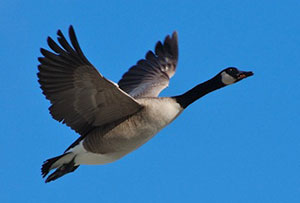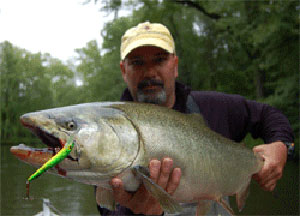- Details
By Louie Stout
 Mille Lacs Lake – Simply Incredible
Mille Lacs Lake – Simply Incredible
Photo courtesy BASS
If you like to catch big smallmouth and lots of them, I have just the place for you.
Mille Lacs Lake, Minn.
Sure, it’s about a 10-hour drive from northern Indiana and not a weekend trip. It’s big water, too, like 132,500 acres, and you’ll need a power boat or hire a guide.
But man, what a smallmouth fishery.
Mille Lacs, located about two hours north of Minneapolis, has long been known as a walleye fishery. The smallmouth have always been there but ignored.
Not anymore.
- Details
By Louie Stout
Worster Lake’s nuisance shad aren’t going away, but Indiana DNR District Fish Biologist Tom Bacula sees a glimmer of hope that their numbers might be held in check.
Bacula ran a quick survey of the Potato Creek State Park lake near North Liberty in June and came away with indications that shad numbers haven’t grown since his last survey there.
Shad are a forage fish that were stocked illegally in Worster some time ago. The DNR has spent thousands of dollars trying to kill off the nuisance fish, but they continually rebound.
Gamefish will eat shad, but once they reach more than 4 or 5 inches – and they often grow to 12 inches and larger – they only create competitive problems for young gamefish, especially panfish. Shad reproduce faster than rabbits and gobble up the tiny aquatic organisms that small sportfish eat. Therefore, the crappie and bluegill suffer slow growth rates and is why panfishing isn’t as good as it should be at Worster.
Without a total lake renovation to kill off all the shad, they will continue to impede young gamefish development. However, Bacula is hopeful that the larger predators in the lake will help keep the shad under control.
That would include unusually big largemouth bass which he documented there in a survey a couple of years ago and the “wipers” that the DNR has stocked since 2001.
Wipers are hybrid fish, a cross between a striped bass and white bass. They get big, although not as big as full-blooded stripers, and have the aggressive feeding tendencies of white bass. The adults are eating machines capable of eating the bigger shad.
Bacula will return to Worster this fall to survey the wipers and get a better idea how they are doing in the lake. He was impressed with the ones he saw recently.
“We have seen them up to 23 inches,” he noted. “I’m anxious to see what we can find when we set nets to target them.”
There were other silver linings he discovered in his last assessment. He encountered more 7-inch bluegill than he’s seen in the past, and a better-than-expected young perch population.
“Perch numbers greatly increased since we surveyed the lake in 2012,” he said. “We didn’t age them, but they were small, and I’m hoping they’ll provide some better perch fishing in the coming years.”
Bacula wishes more anglers would target the wipers, although they are an offshore fish and generally not accessible to bank anglers.
Wipers will take large minnows drifted well beneath a bobber, but shiny spoons, crankbaits (especially lipless versions), or bucktail jigs tipped with a large white grub will tempt them as well. If you’re fishing from a boat, watch your electronics for big marks as you trolling motor through deep water. Wipers are a schooling fish, so where you find one, you’re likely to find several.
“We stock wipers as a biological control on the larger shad,” said Bacula. “But they also provide fishing opportunities and we do wish more anglers would fish for them.”
- Details
By Louie Stout
 Waterfowlers Anticipate Banner YearIts going to be a great year for goose hunters.
Waterfowlers Anticipate Banner YearIts going to be a great year for goose hunters.
Thats the reports coming in from waterfowl managers monitoring goose production throughout the flyway and Indiana is no exception.
Those surveys include more than the birds hanging out at city parks that we already know about.
Indiana DNR waterfowl biologist Adam Phelps said banding projects here and elsewhere indicate gosling production last spring was as high or higher - as hes ever seen it.
Its going to be a great year for goose hunters, said Phelps. And this year, hunters can hunt geese into February.
The northern Indiana early goose season opened Saturday dates and runs to Sept. 11. Other seasons are Oct. 22 to Nov. 20, and Dec. 10 to Feb. 12.
- Details
By Louie Stout
 DNRs alter salmon cut plan; Michigan meeting set.Lake Michigan fish managers have altered their previously proposed cuts for next years lake-wide trout and salmon stockings.
DNRs alter salmon cut plan; Michigan meeting set.Lake Michigan fish managers have altered their previously proposed cuts for next years lake-wide trout and salmon stockings.
Initially, the Lake Michigan Committee had proposed a 61 percent in chinook (king) salmon stockings to alleviate pressure on a dwindling alewife forage base, but recently relaxed that number in a compromise with anglers who have objected with the cuts.
A new proposal announced to Hoosier anglers at a meeting in Michigan City earlier this month, and one that will be explained to Michigan anglers next month, calls for a 50 percent reduction instead of the 61 percent.
Indiana originally announced it would eliminate king stockings for next year and utilize the hatchery space to grow steelhead bigger for a later stocking which would enhance better survival.
